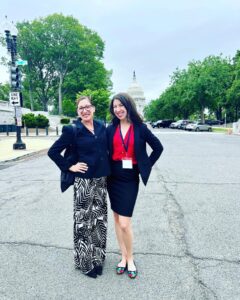I was never really interested in politics. While my college friends were raving about their poli sci classes, I buried my nose in biochemistry textbooks. I thought politics and medicine didn’t mix, and I preferred it that way.

Dr. Shapiro
But then I became the first rheumatologist at a federally qualified health center. On my first day, the referral list to see me included 1,245 patients.1 Obtaining medications to care for these patients was a daily struggle, as were my complaints about our broken system.2
I watched as patients deteriorated before my eyes while waiting for biologics. And then one day, I got an email soliciting applications for positions on ACR committees. I saw this as a chance to take action. The potential professional benefit to me as an academic rheumatologist shooting for promotion also motivated me to apply. A few months later, I became the newest member of the Insurance Subcommittee (ISC) of the Committee on Rheumatologic Care. I didn’t know much about insurance. But I was willing to learn.
ACR Insurance Subcommittee
The ISC meets once a month to advocate for coverage and payment policies that benefit rheumatology patients and providers alike. ACR members may submit complaints about unfair insurance practices via the ACR website. Then, the ISC uses the power of the ACR to write letters to and schedule meetings with payers to effect change.
For example, the ISC learned that multiple payers are denying apremilast in combination with biologics for patients with psoriatic arthritis and residual skin lesions. As a team, we drafted a letter to the payer in question to advocate for a policy change. Note: An editable version of the letter will soon be available online to all ACR members should they encounter similar trouble in their practices.3
In many ways, ISC work can feel like a game of Whac-A-Mole—when we knock one nasty policy down, another springs up in its wake. But it sure feels good to do something more than just complain.
Advocacy Leadership Conference

At the Advocacy Leadership Conference, Dr. Shapiro met up with a former mentor, Rebecca Manno, MD, MHS (left).
In May 2022, my fellow ISC members and I, as well as members of several other ACR committees, were invited to meet in Washington, D.C., at the Advocacy Leadership Conference (ALC). ALC includes committee meetings, but these aren’t the main event. The real draw is advocacy training, followed by the opportunity to meet with one’s members of Congress on Capitol Hill.
ALC kicked off with our regular monthly ISC meeting. It was great to finally meet my fellow committee members in person! This month, we tackled CVS Caremark’s prior authorization forms. For months, ACR leaders have been negotiating with CVS to decrease the number of questions on these forms. So far, we’ve successfully removed eight questions from the adalimumab prior authorization form. There are more to address, but it’s a start, especially given the daily burden these forms place on providers and staff.
Hill Training
After lunch, we sat down for Hill training. Committee meetings are important, but the real reason the ACR brings volunteer leaders to Washington, D.C., every year is to advocate on Capitol Hill.
I was nervous. I had seven meetings scheduled the following day, two with the Texas senators and five with Texas representatives. But what did I know about advocacy? What did I know about bills becoming laws? After all, I’m a doctor, not a politician.
The nerves were short-lived because Hill training was excellent. You may not realize this (I didn’t!), but several ACR staff members work on the Hill daily, lobbying for legislation that benefits and protects rheumatology patients and providers. But hearing from constituents—especially practicing clinicians—carries a lot of influence as legislators decide which bills become laws.
During training, ACR staff reviewed how a bill becomes a law, how election years influence the likelihood of members of Congress co-sponsoring new legislation and which bills we should discuss. Most importantly, they detailed best practices and tips for successful Hill visits. There was even a mock Hill visit session so we could see how it’s done and ask questions as needed.
This year, the ACR asked us to elicit support for two bills: the Resident Physician Shortage Reduction Act (H.R. 2256/S. 834) and the Help Ensure Lower Patient (HELP) Copays Act (H.R. 5801).
The Resident Physician Shortage Reduction Act would increase the number of Medicare-supported direct graduate medical education and indirect medical education resident and fellow training positions by 14,000 over seven years. It would specifically address the growing rheumatology workforce shortage by requiring that at least 50% of slots each year go to shortage specialty programs like rheumatology.4 It would also give special consideration to slots at hospitals emphasizing training in community-based settings, rural areas and programs with integrated rural tracks.
The HELP Copays Act would effectively ban copay accumulator programs that disallow copay assistance (e.g., pharmaceutical company copay cards) from counting towards a patient’s annual deductible and out-of-pocket maximum.5,6 The ACR has fought copay accumulator programs on the state level, and 14 states and Puerto Rico have enacted legislation that requires any payment or discount made “by or on behalf of the patient” be applied to their annual out-of-pocket cost-sharing requirement. But similar legislation on the federal level is needed to outlaw copay accumulator programs and protect patient access to the expensive but life-changing medications they need.
Hill Visits
The next day was go-time. Hill visits were a mix of virtual and in-person meetings, with in-person the clear favorite among attendees. For the most part, we met with health legislative assistants (HLAs) and not the congresspeople themselves, but that didn’t detract from the experience in the slightest. HLAs research health-related topics and advise elected officials on legislation coming down the pipeline. So, they’re often the most knowledgeable and influential people to chat with when asking for bill support.
Visiting my state representatives in their offices could only be described as awesome. We provided a brief overview of each bill, but we weren’t there to be legislation experts. We were there to bring the impacts of the bills to life with clinical stories from the frontlines.
Writing about a 1,245-patient referral list for The Rheumatologist is one thing; sharing that figure with an elected official who could support legislation to address the workforce shortage is another. Similarly, ranting about how copay accumulator programs prevent my patients from accessing medications while saving insurance companies and pharmacy benefit managers dollars is one thing; sharing these stories with someone who might actually be able to ban these programs is much better.
In many ways, I became a rheumatology advocate by accident. But I can’t stress enough how happy I am to be here. Want to become a deliberate rheumatology advocate? ACR committees and the ALC are great places to start. These were my first Hill visits, but they certainly won’t be my last.
If you are interested in participating in future events like these, you can sign up to get the latest updates on the ACR’s Advocates for Arthritis, to which all ACR/ARP members are welcome to apply. Be the first to know when the application period opens this summer!
Samantha C. Shapiro, MD, is an academic rheumatologist and an affiliate faculty member of the Dell Medical School at the University of Texas at Austin. She received her training in internal medicine and rheumatology at Johns Hopkins University, Baltimore. She is also a member of the ACR Insurance Subcommittee.
References
- https://acrabstracts.org/abstract/rheumatology-care-for-the-underserved-in-central-texas/.
- https://www.the-rheumatologist.org/article/lessons-from-caring-for-the-underinsured-uninsured/.
- https://www.rheumatology.org/Practice-Quality/Administrative-Support/Insurance-Advocacy/Tools-Resources.
- Battafarano DF, Ditmyer M, Bolster MB, et al. 2015 American College of Rheumatology Workforce Study: Supply and Demand Projections of Adult Rheumatology Workforce, 2015–2030. Arthritis Care and Research. 2018;70(4):617-626.
- https://www.goodrx.com/insurance/health-insurance/copay-accumulator-programs-cms-ruling.
- https://www.goodrx.com/healthcare-access/patient-advocacy/what-are-manufacturer-copay-cards.
